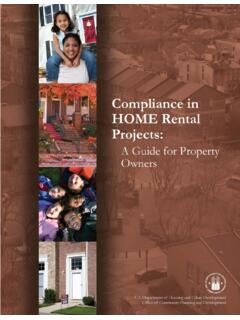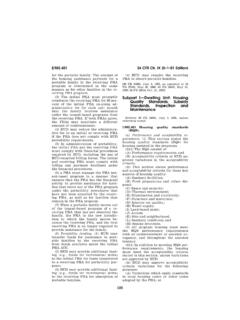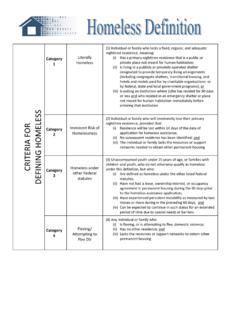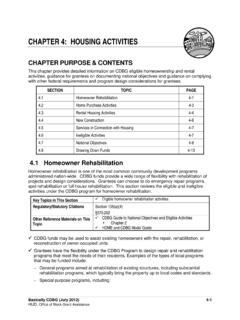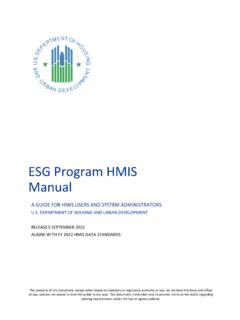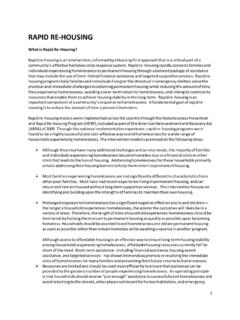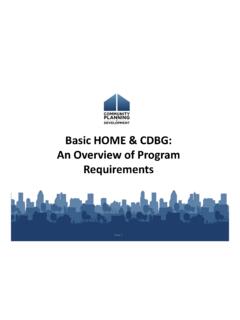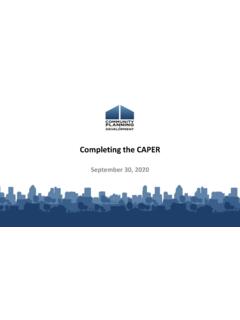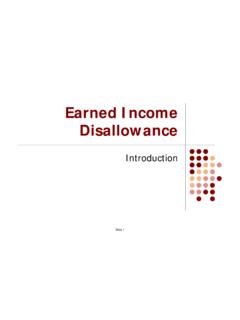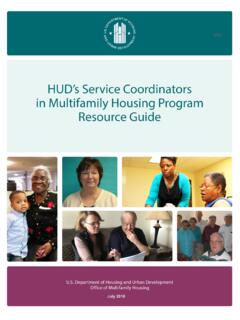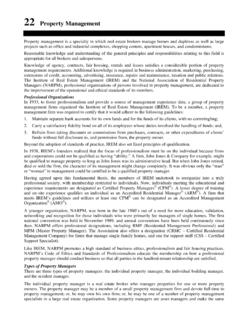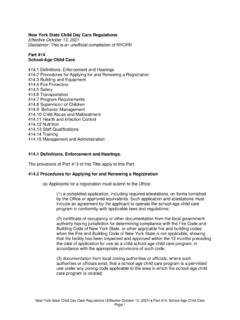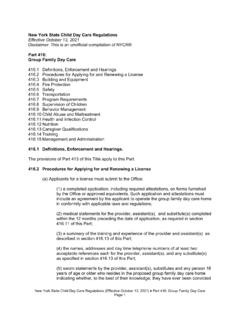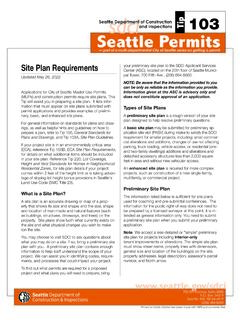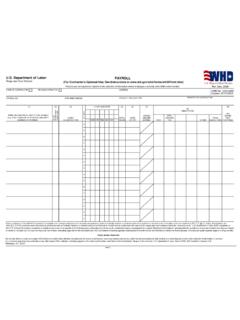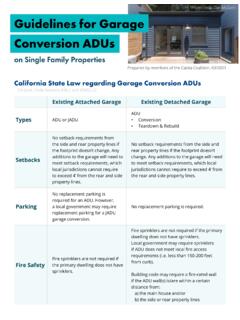Transcription of HOME and CDBG Guidebook - HUD Exchange
1 Foreword One of the major priorities of the department of Housing and Urban Development (HUD) is the creation of affordable housing. The department administers several Federal programs that assist state and local governments, as well as nonprofits and other partners, to develop affordable homeownership and rental units for low-income households. Two of the most important programs are the HOME Investment Partnerships Program (HOME) and the Community Development Block Grant (CDBG) Program. Both HOME and CDBG are important resources in the local development of homes and communities. While sharing similar goals related to improving the living conditions of low-income families, each program differs in its eligible activities and requirements. In addition, there is a tremendous need for affordable housing in many communities and these needs often exceed available resources. So, it is important that state and local governments make strategic decisions about how to spend their HOME and CDBG funds.
2 HUD s Office of Affordable Housing Programs, in partnership with HUD s Office of Block Grant Assistance, developed this Guidebook as a tool for community development practitioners to assist in making these strategic choices about HOME and CDBG resources for affordable housing. Its purpose is to provide practical guidance on how both HOME and CDBG requirements are interpreted and to provide examples of how the two funding sources might be used in tandem. The department encourages communities to seek strategic, effective, and innovative ways of using two of its most important affordable housing resources the HOME and CDBG Programs. HOME and CDBG Table of Contents Introduction .. 1 Making Effective Use of Program Resources .. 1 Selecting Suitable Activities .. 1 Complying with the Rules .. 2 Leveraging CDBG and HOME .. 3 Planning for CDBG and 3 Assessment of Community Needs .. 3 Community-Wide 3 Individual Project 4 How to Use this 4 About the Model Program Guides.
3 5 Chapter 1: HOME and CDBG Basics .. 6 What is HOME? .. 6 HOME Program Partners .. 6 HOME Program Activities .. 7 Eligible Costs .. 7 Prohibited Activities and Costs .. 8 HOME Program Requirements .. 9 Income Eligibility and Verification .. 9 Subsidy Limits .. 10 Affordability Periods .. 10 Maximum Value .. 10 Property 11 HOME Administrative 11 Administrative and Planning Costs .. 11 Match .. 11 Commitment and Expenditure Deadlines .. 12 Program Income .. 12 Pre-Award Costs .. 12 What is CDBG? .. 13 CDBG Program Partners .. 13 CDBG Program Activities .. 14 Eligible CDBG Activities .. 14 Ineligible CDBG 15 CDBG National Objectives .. 15 Benefit Low- and Moderate-Income Persons .. 16 Elimination of Slum and Blight .. 17 Urgent Need .. 17 CDBG Administrative Requirements and Caps .. 18 Administrative Cap .. 18 Low- and Moderate-Income Benefit Expenditures .. 18 Public Services 19 Program Income .. 19 Timely Use of Funds.
4 20 Pre-Award Costs .. 20 HOME and CDBG i Chapter 2: Using HOME and CDBG for Rental Housing .. 26 Approaches to Creating Rental Housing .. 26 Acquisition .. 26 Tenant-Based Rental 27 28 New 28 Financing and Developing Rental 29 30 Forms of Assistance .. 33 Eligible 35 Assisted Units .. 36 Eligible Costs .. 37 Property and Neighborhood Standards .. 38 Other Federal Requirements .. 38 Ongoing Compliance .. 38 Affordability Period .. 38 Rent Requirements .. 39 Income 40 Ongoing Property Quality .. 41 Chapter 3: Using HOME and CDBG for Homeownership .. 42 Approaches to Creating Homebuyer Units .. 42 Development 42 Direct Homebuyer Subsidy Approach .. 43 Financing and Developing Homebuyer Housing .. 46 Eligible Property 49 Property 50 Other Federal Requirements .. 50 Ongoing Requirements .. 50 Affordability Period .. 50 Recapture Option .. 51 Resale Option .. 51 Enforcing Resale and Recapture 53 Low-Income Targeting.
5 53 3-1: American Dream Downpayment Initiative (ADDI) Side-By-Side Comparison of Downpayment Assistance Requirements By Source of Funds .. 55 Chapter 4: Using HOME and CDBG for Homeowner 57 Approaches to Homeowner Rehabilitation .. 57 Minor 57 Moderate/Substantial Rehabilitation .. 57 Reconstruction .. 58 Historic 59 Lead-based Paint Hazard Evaluation and Reduction .. 59 Code Enforcement .. 60 Home-based Business Rehabilitation .. 61 Financing and Undertaking Homeowner 61 61 Forms of Financial Assistance .. 61 Eligible Costs .. 64 Property and Rehabilitation Standards .. 65 HOME and CDBG Initial Owner Incomes .. 66 Other Federal Requirements .. 67 Chapter 5: Using HOME and CDBG for Comprehensive Neighborhood Revitalization ..68 Approaches to Neighborhood 68 Planning Models for Urban 68 Housing 69 Property Inspections and Code Enforcement .. 69 Infrastructure Development and Improvement .. 70 Economic 70 Community Facilities and Public Services.
6 71 Financing and Requirements for Neighborhood Revitalization .. 71 71 Approaches to 72 Eligible Costs .. 74 Chapter 6: Making Strategic Investment Decisions .. 75 Step 1: Evaluate community needs and preferences .. 76 Step 2: Determine program types based upon needs and preferences .. 77 Step 3: State intended program outcomes .. 78 Step 4: Evaluate the strengths of HOME and CDBG v. intended 78 Step 5: Assess CDBG and HOME constraints .. 80 Step 6: Determine whether program should be co-funded with HOME and CDBG .. 81 Step 7: If co-funded program, evaluate each project to determine appropriate uses of funds .. 82 Administering Programs .. 83 Choosing Projects and Partners .. 83 Setting Up Adequate Financial Systems .. 85 Developing Efficient Reporting and Record Keeping Systems .. 86 Reviewing Program Performance and Compliance .. 87 Endnotes .. 90 iii HOME and CDBG Introduction Two programs form the cornerstone of the department of Housing and Urban Development s (HUD s) community development efforts the HOME Investment Partnerships Program and the Community Development Block Grant (CDBG).
7 Across the country, HOME and CDBG funds are helping communities develop new affordable housing for both renters and homebuyers, rehabilitate existing homes, and turn around troubled neighborhoods. While HOME and CDBG share the same goals the growth and improvement of America s communities the programs differ in important ways. For example, HOME and CDBG have different eligible activities, different approaches to meeting the needs of low- and moderate-income families, and different rules regarding matching funds. By using HOME and CDBG funds strategically, communities can optimize their use of both funding sources, while working within the limitations and regulations of both programs. HOME and CDBG: Working Together to Create Affordable Housing is the community development professional s guide to using HOME and CDBG funds for affordable housing activities as strategically as possible. This model program guide begins by outlining how HOME and CDBG work and by identifying critical differences between the two programs.
8 Next, the guide provides a detailed consideration of how to use HOME and CDBG to support rental housing, homeownership, rehabilitation, and comprehensive neighborhood revitalization projects, giving special attention to how to coordinate the two funding sources. The guide concludes with some final considerations for making strategic investment decisions using HOME and CDBG. Throughout the guide, the discussion will focus on the importance of using program resources effectively, and how this can be done to meet local housing and community development needs, and to stay in compliance with Federal program rules. Making Effective Use of Program Resources Community development is a broad term that encompasses a wide range of activities, including housing, economic development, health, employment and educational services, infrastructure, and many other activities designed to improve the welfare of neighborhoods and families.
9 In towns, counties, and states across America, community development remains a primary concern for local leaders, the staffs of nonprofit and public agencies, and citizens alike. Yet, Federal resources for community development are limited and are not sufficient to address all of the needs in most jurisdictions. While HOME and CDBG can play an important part in addressing community development needs, they must be used wisely in order to obtain the maximum benefit from each resource. It is important that jurisdictions use these programs strategically because: Some types of activities are better suited to be undertaken under one program than the other; When combining these resources within projects, it is important that the rules for each program be followed; and Effective leveraging of CDBG and HOME resources can mean a generating a greater bang for the buck than when each program is used alone. Selecting Suitable Activities When Congress enacted the CDBG and HOME Programs, it had differing objectives in mind.
10 CDBG was created to consolidate a number of previous categorical grant programs that had addressed a range of community needs, including water and sewer, urban renewal, model cities, historic preservation, and neighborhood development. CDBG s eligible 1 HOME and CDBG activities, therefore, are diverse and range from residential rehabilitation to infrastructure to public services. While it has a strong focus on meeting the needs of low-income persons, it is also designed to be flexible in order to address other concerns. The HOME Program was created nearly two decades later, to address the growing affordable housing crisis in America. Its purpose is to increase the supply of affordable housing for low-and very low-income households. There are four eligible activities under HOME and all relate directly to affordable housing. In addition, HOME has a secondary purpose of supporting the development and sustainability of nonprofit housing providers.
